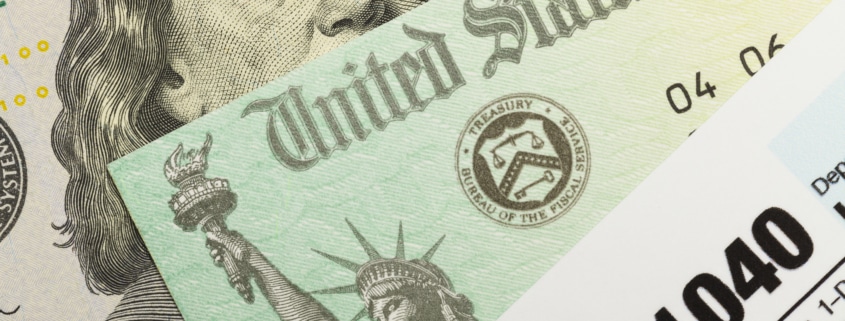Should You Break Even or Make Bank on Your Tax Returns?
Have you noticed how many tax preparation firms and other companies hype up tax refunds? While getting a large tax refund may seem exciting, you could have had that money already with a proper withholding strategy. At S.H. Block Tax Services, we think you should hold onto your hard-earned money.
Keep reading to learn more about why people prefer a bigger refund over a bigger paycheck, what you’re missing by withholding extra money, and how an experienced tax lawyer can help you break even on your taxes.
What’s Wrong With a Big Tax Refund?
For many taxpayers, getting that big tax refund each spring is like getting a second Christmas or an early birthday. Even if you know that it’s your own money the IRS is returning to you, it’s hard not to be excited by that check in the mail or deposit in your account.
Most taxpayers know that they’re getting a refund because they overpaid their taxes throughout the year. But, they assume that there’s no harm in the practice. However, where is your money if it’s not in your paycheck where it belongs? Answer: the government is using it.
Instead of earning interest on your money by keeping it in your paychecks and depositing into your bank account, you’re giving it to the government. When you withhold too much from your paycheck, you’re giving the government an interest-free loan.
There’s nothing inherently wrong with this. Whether or not you make bank or break even on your tax returns is unlikely to make a huge difference to your overall financials. But you’re missing out on this interest year after year, and that can add up if you file extensive tax returns.
Financial Fallacies: Why People Choose Bigger Refunds Over Bigger Paychecks
There are many reasons that taxpayers choose receiving a bigger refund over having a slightly bigger paycheck each month. You may arrange for a larger refund out of habit. Other people use their tax refund as a budgeting tool, and pay off their debt. Others love the thrill of a big refund or want to use it as a “fun fund.”
The fallacy? You can do all those things more efficiently with just a little bit more effort on your part.
Earn Interest for the Things You Love and Need
Instead of paying excess taxes on each paycheck, put a small percent of your paycheck in a separate account each payday. Not only will this give you more control of the money in your post-holiday or fun fund, but you’ll also earn interest on the funds. Some common uses for these accounts include:
- Retirement
- College for children and grandchildren
- Emergencies
- Home repairs
- Vacations and shopping sprees
Pay Down Your Debts Throughout the Year
Do you use your tax return money to pay off debts? Instead of making one large, unknown payment every spring, you could whittle down the balance on your credit cards or mortgage throughout the year. By paying a little each month, you’ll be able to steadily decrease your debts and gain a better sense of where you are at financially.
If you use your tax refund to pay off your bills, you have less control over your debts and don’t know how much you’ll be able to pay off until you calculate your estimated tax return. Paying down debts monthly rather than once a year has other benefits as well, such as:
- Evening out your cash flow
- Saving on payment interest
- Building better debt habits
- Improving your credit score
- Providing a sense of accomplishment
How to Break Even on Your Tax Returns
So how do you know how much to withdraw from your paycheck to break even? Estimating taxes is not an exact science, but there are tools you can use to get close. You can also work with a tax advisor for more accurate estimations of your taxes and withholding suggestions.
Calculate How Much You’re Paying and How Much You Should Be Paying in Taxes
First, you’ll need to figure out how much you are currently withholding each year and how much the IRS estimates you should be withholding.
-
- Check your paystub to see how much you are currently having withheld for federal income taxes.
- Multiply that number by how many paychecks you get in a year.
- If you’re married filing jointly, calculate how much your spouse withholds each year and add that to your annual total.
- Collect a copy of your most recent tax return and any other tax-related documents, and enter your information into the IRS withholding calculator for your estimated tax liability.
- Subtract your estimated tax liability from your annual withholdings. A positive balance means you have a refund coming, while a negative balance means you’re going to get a bill.
RELATED ARTICLE: S.H. Block Can Help You Manage Your Withholdings and Any Unexpected Taxes Owed
Update Your W-4 Withholding Allowances
To increase or decrease your withholdings, you’ll need to fill out and submit an updated W-4 to your employer. You can download the W-4 form from the IRS website or ask your employer for a copy of the form.
-
- Positive Balance: If you have a large refund coming and want to get the most out of your paycheck by breaking even, the best way to decrease your withholdings is by increasing your personal allowances.
- Negative Balance: If your calculations indicate a negative balance and potential bills and penalties for underpaying, one option is to decrease your personal allowances. The W-4 also has a place where you can elect to withhold a specific amount in addition to the amount withheld according to your personal allowances.
Questions About Your Taxes and Withholding? Contact S.H. Block Tax Services
Accurately calculating your taxes and adjusting withholdings to break even can be difficult, especially if you have many exemptions and other unique tax situations. The best way to make the most of your paycheck and break even on your taxes is to work with experienced tax advisors. Contact S.H. Block Tax Services if you have any questions about your taxes or need help estimating your optimal tax withholdings. Call us today at (410) 872-8376 or complete the brief contact form to the right to get started.
The content provided here is for informational purposes only and should not be construed as legal advice on any subject.












Leave a Reply
Want to join the discussion?Feel free to contribute!